

Collaborative Rehabilitation in Acute Stroke - Faculty of Medicine and Health - University of Leeds. Using co-production to improve patient carer and staff experiences in health care organizations: a multi-centre, mixed methods evaluation in inpatient stroke units.
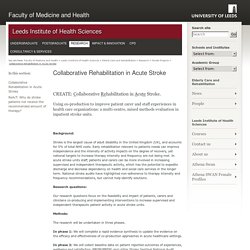
Background: Stroke is the largest cause of adult disability in the United Kingdom (UK), and accounts for 5% of total NHS costs. IASDR Conference 2015. Doctors have become less empathetic, but is it their fault? ‘I don’t like to take medications,’ Hernando (not his real name) told me when I recommended a strong dose of ibuprofen for the pain in his thumb during an even busier day than usual in the primary care clinic where I work.
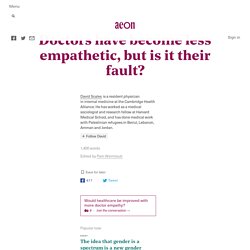
I’m not his regular doctor so he tried to explain that he preferred natural treatments to manufactured pharmaceuticals. We can work with that, I thought. But then he said: ‘I’d prefer not to wear a wrist brace,’ a key component of treatment for his tendonitis. This visit was not going how I had hoped. I was rushed and already 40 minutes behind schedule, hoping to catch up. Like Hernando, most people want an empathetic doctor, someone who can prescribe medications but also someone who listens and understands.
The key resides in the nature of clinical empathy, which requires that the practitioner be truly present. At times, empathy’s impact seems more magical than biological. If the case for empathy is clear, the way to boost it remains murky indeed. Australian Institute for Patient and Family Centred Care. The Australian Institute for Patient and Family Centred Care (AIPFCC) was established in 2009 to transform the quality and safety of Australian healthcare by encouraging effective and innovative partnerships between patients, families and healthcare professionals.

In February 2016 the Institute merged with the Hush Music Foundation to form the Hush Foundation. Dr Catherine Crock is the Executive Director of the Hush Foundation. Associates: The Institute has approximately 400 Associates across Australia, New Zealand, Canada, United States and Japan. International Alliance of Patients' Organizations. How to use this toolkit - Health Service Co-Design. TED Book: The Laws of Medicine. Strategic Innovation Lab (sLab) By prioritizing the human experience of both the patient and the healthcare professional, emphasizing inclusive design, human factors, and human-environment interactions, the design community is positioned to positively impact the health and wellness domain.
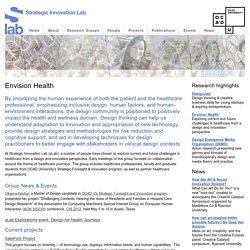
Co-creating Health. Co-designing with Children. By Catalina Naranjo-Bock Published: April 2, 2012 “Many of my most rewarding and insightful research experiences have included children as co-designers in a product development process.”
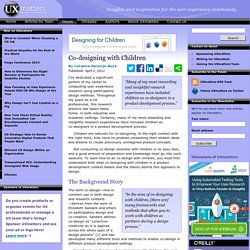
I’ve dedicated a significant portion of my career to conducting user experience research using participatory design methods. Throughout my years as a UX professional, this research practice has taken many forms. in both industrial and academic settings. Certainly, many of my most rewarding and insightful research experiences have included children as co-designers in a product development process. Children are naturals for co-designing. But conducting co-design sessions with children is no easy task, and a good amount of preparation and knowledge must go into such sessions. Co-designing with the State Library of Victoria: How we did it, and why it paves the way for change. Recently Meld Studios partnered with the State Library of Victoria to help envision a way it might do things differently (and better) in the future.

A future where the services they offered remained relevant to customers and created positive experiences for visitors and staff. This did not mean telling the Library what to do and expecting the future to be a reality tomorrow. We both understood it was critical to engage the broader organisation throughout the project so that the shift required could actually happen.
For this reason, the project was designed with a commitment to co-design, where a team of three service designers from Meld Studios and two Library staff (Ben and Bridie) worked hand in hand to build a shared vision for the Library’s future. Our collective team worked and learned together. A team effort! Design with them, not at themBen and Bridie are embedded in the organisation and have the relationships that can breed advocates. Teach, don’t delegate. SSIR Design for Support. Home - Health Service Co-Design. Design for Care. Design Council is seeking funds for Design for Care from trusts, foundations, public and private funds and third sector organisations.
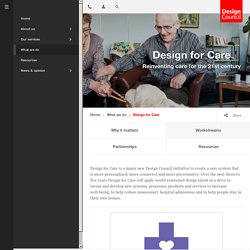
We have identified three main partnership levels: Investment Partner A small number of public, private and third sector organisations to seed fund the initial stages of the programme. Once the solutions are clearer, we expect there to be the opportunity for investment partners to ‘pick and choose’ what ideas they wish to invest in; but to start with we propose a pooled programme fund. Investment partners may well increase in number in the latter stages. Delivery Partner The innovations and knowledge generated will be of global relevance, but we must start more locally, piloting in multiple UK localities before scaling internationally in later phases. Expert Supporter This programme will only succeed with the engagement and support of care professionals.
Partner with us We work with businesses, local authorities, universities, and foundations. Find out how.